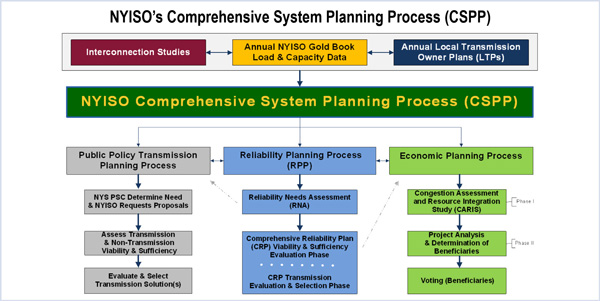By Michael Kuser
RENSSELAER, N.Y. — NYISO’s Management Committee voted unanimously to recommend board approval of the grid operator’s 2016 Comprehensive Reliability Plan despite concerns about locational planning requirements and the shutdown of the Indian Point nuclear plant.
The CRP is prepared every two years. Laura Popa, manager of reliability planning, told the committee that under the conditions studied in the 2016 Reliability Needs Assessment, the grid’s bulk power transmission facilities meet all applicable reliability criteria from now through 2026.
Last October, officials identified two reliability needs: the Oakdale 345/115-kV substation in the NYSEG zone and the East Garden City-Valley Stream 138-kV line in PSEG-LIPA. In November, however, the transmission operators presented local transmission plans and operational procedures that eliminated the two needs.
Kevin Lang of law firm Couch White, representing New York City, said the grid operator should have considered in its CRP the closure of the Indian Point nuclear plant, whose two units are set to be shut down successively in 2020 and 2021. “I don’t think it’s appropriate to wait for a Notice to Retire, and it’s certainly important to New York City,” Lang said. He urged NYISO to go ahead with that analysis.
The grid operator contends, however, that it is pointless under the prevailing fast-changing market conditions to do a full reliability study before they receive a formal notice to retire the plant. (See NYISO, PSC: No Worries on Replacing Indian Point Capacity.)
David Patton, head of NYISO’s Market Monitoring Unit, said the MMU had concerns about locational planning requirements under the current rules. Some wind farms, for example, might be located in places that aggravate transmission constraints. “In particular, we find that market incentives for investment in resources in certain areas of the 115-kV system in upstate New York are inadequate partly because these lower voltage constraints are not reflected in the NYISO’s energy and ancillary services markets,” he said. “This has contributed to the need for cost-of-service contracts to keep older capacity in service.”
Patton recommended the ISO consider managing upstate 115-kV constraints in the day-ahead and real-time markets that currently require supplemental commitments, out-of-merit dispatch and other expensive operator actions.
Howard Fromer, director of market policy at PSEG Power New York, said that the CRP failed to mention any adjustments “to accommodate vast new changes in our intermittent energy supply. We don’t yet have a good answer to the question of ‘Will we have a reliable system?’”
Lang questioned the validity of the Monitor’s approach. “Some of these resources are coal plants that are 50 years old or older, or nuclear plants,” he said. “These resources are also being pushed out for policy reasons, not just market reasons. Low natural gas prices are competitive forces. … I don’t see any real analysis in your comments. Where’s your cost-benefit analysis?”




